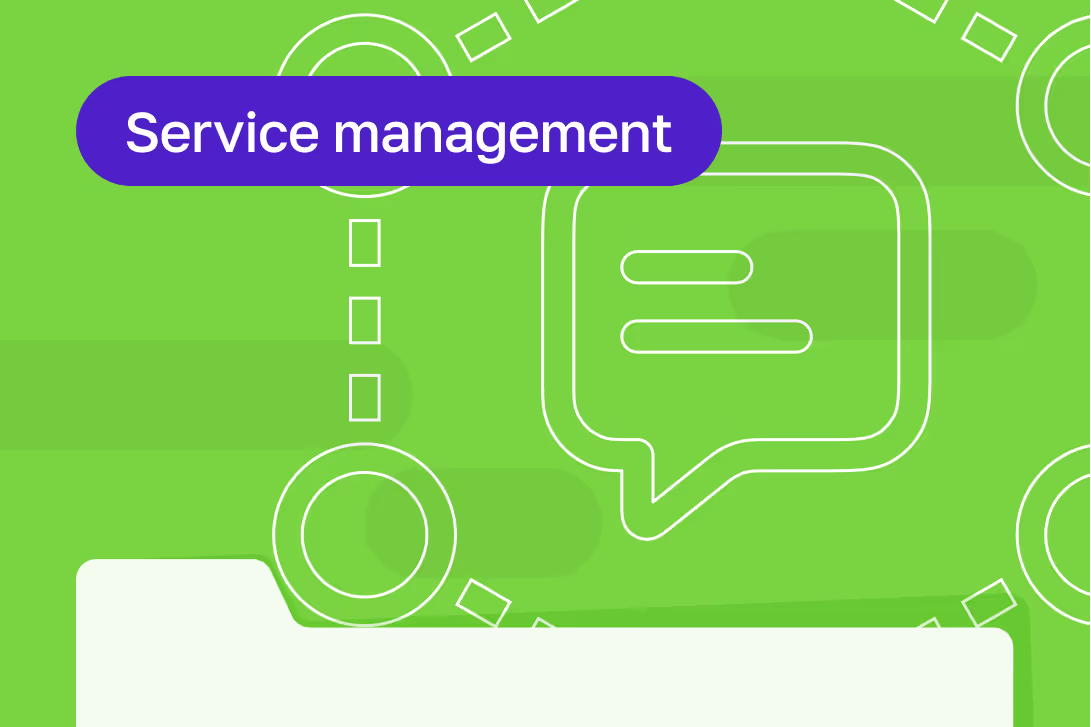What is IT service management?


Listen to this blog as a podcast

.png)
If you’ve ever wondered how IT teams keep everything running — from onboarding employees to restoring downed systems — you’re looking at IT service management in action.
When your laptop dies minutes before a big presentation, or a new hire gets access to everything on day one — that’s not magic. That’s IT service management working behind the scenes.
Let’s break down what IT service management is, how it works, and why it matters for growing tech companies.
What is IT service management (ITSM)?
IT service management is the process by which IT teams design, deliver, manage, and continually improve the services they provide to the business.
That includes everything from handling user requests to troubleshooting outages and rolling out new systems, while ensuring everything remains secure, efficient, and aligned with business goals.
It’s not just about fixing what’s broken. It’s about running IT like a service, not just a department.
Why ITSM matters
When IT grows without structure, support becomes reactive. Tickets pile up. Changes get messy. Teams burn out.
ITSM provides a framework to maintain control.
It helps you:
- Respond faster to issues
- Deliver consistent support
- Track and improve performance
- Align IT with business needs
In short, it helps IT act as a strategic partner — not just a help desk.
The most common ITSM frameworks
There’s no one-size-fits-all approach to ITSM, but over the years, several frameworks have emerged to help organizations implement ITSM in a structured way. The most well-known include:
ITIL (Information Technology Infrastructure Library)
Ideal for mid-size to large teams ready to formalize service delivery, ITIL is the most widely used framework. ITIL breaks down ITSM into clear processes like incident management, change management, and service request fulfillment. It’s flexible and easy to adapt based on your team’s size and goals.
COBIT (Control Objectives for Information and Related Technologies)
Often adopted by finance-heavy or heavily regulated industries, COBIT focuses more on IT governance, making sure IT decisions align with business goals. It’s often used by larger organizations with strict compliance needs.
ISO/IEC 20000
Best suited for orgs needing external validation or audit readiness, ISO/IEC 200000 is an international standard that formalizes ITSM best practices. It’s more about certification and quality control. Most helpful when external validation or compliance is a priority.
You don’t have to follow any of these word-for-word. The goal is to take what fits your environment and leave the rest.
Core ITSM processes to know
ITSM covers a wide range of operations, but a few foundational processes show up in nearly every setup. Here’s what they are — and what they look like in practice.
Incident management
This is the frontline of ITSM. It covers how your team handles unplanned interruptions—think broken laptops, email outages, or software bugs. The goal is to restore service as quickly as possible.
Problem management
Digging into the root cause of recurring issues. If password reset systems keep failing or one department consistently experiences access issues, this process identifies and resolves the underlying pattern.
Change management
Making updates to your systems — without breaking things. This includes new software rollouts, patches, and infrastructure changes. The goal is to reduce risk while moving forward.
Other common processes include asset management, service request fulfillment, and configuration management. But if you're just starting out, these three are a solid foundation.
How organizations implement ITSM
Most teams start simple. Maybe it’s a shared inbox, a basic ticketing system, or a few documented workflows. Over time, that evolves into more formal processes and tools.
Here’s what a good starting point looks like:
- A single system to track and manage tickets
- Defined categories for requests, incidents, and changes
- A basic process for escalating or routing work
- Regular reviews to spot patterns or bottlenecks
From there, it’s about refining what works. Better documentation. Smarter routing. Integrated tools. And most importantly, getting feedback from users and the team doing the work.
ITSM doesn’t have to be overkill
It’s easy to think of ITSM as a giant enterprise project — but that’s not the point.
Good ITSM is about clarity, consistency, and making life easier for everyone. It helps small teams move faster, reduce fire drills, and focus on the work that matters.
You don’t need to implement a full ITIL suite or get ISO-certified to see value. Even a few streamlined processes — like better incident workflows or smarter change approvals — can free up time, reduce escalations, and improve the user experience.
Whether you’re formalizing processes for the first time or just looking for a cleaner way to manage support, ITSM gives you a framework to do it with intention.
And if you're looking for a partner to help automate, analyze, or streamline your help desk, Fixify is built for that. We bring structure without the bloat.
Book a demo today.
Related articles

Fixify’s Insights Dashboard: Real-time insights, zero guesswork


A quick offboarding checklist for tech companies


What is an enterprise service desk? Features and benefits

Stay in the loop

Sign up to get notified about our latest news and blogs
.png)